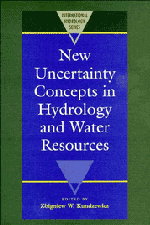Book contents
- Frontmatter
- Contents
- List of Authors
- Preface
- I INTRODUCTION
- II FACETS OF UNCERTAINTY
- III NOVEL APPROACHES TO UNCERTAINTY: FRACTALS, FUZZY SETS AND PATTERN RECOGNITION, NON-PARAMETRIC METHODS
- IV RANDOM FIELDS
- V TIME SERIES AND STOCHASTIC PROCESSES
- VI RISK, RELIABILITY AND RELATED CRITERIA
- 1 Stochastic approach to non-point pollution of surface waters
- 2 Statistically safe sets methodology for optimal management of reservoirs in risk situations
- 3 Risk assessment in control of reservoir systems
- 4 Reliability-related criteria in water supply system studies
- 5 Reliability analysis of reservoir operation
6 - Composite risk model of Ogee type spillway
Published online by Cambridge University Press: 07 May 2010
- Frontmatter
- Contents
- List of Authors
- Preface
- I INTRODUCTION
- II FACETS OF UNCERTAINTY
- III NOVEL APPROACHES TO UNCERTAINTY: FRACTALS, FUZZY SETS AND PATTERN RECOGNITION, NON-PARAMETRIC METHODS
- IV RANDOM FIELDS
- V TIME SERIES AND STOCHASTIC PROCESSES
- VI RISK, RELIABILITY AND RELATED CRITERIA
- 1 Stochastic approach to non-point pollution of surface waters
- 2 Statistically safe sets methodology for optimal management of reservoirs in risk situations
- 3 Risk assessment in control of reservoir systems
- 4 Reliability-related criteria in water supply system studies
- 5 Reliability analysis of reservoir operation
Summary
ABSTRACT In the existing design methods consideration is given to stochastic processes of flood flows imposed on the structure in order for the hydrological uncertainty to be accounted. However, there are also various uncertainties associated with flood conveyance structures which have to be considered in the design of hydraulic structures. A static model integrating hydrological and hydraulical uncertainties in the design of the Ogee spillway is devised in the present contribution. Results show that the conventional method of the evaluation of risk, where hydrological risk only is accounted, produces underestimation of the risk of failure. This becomes particularly significant if the return period and the safety factor are large.
INTRODUCTION
There are many parameters and variables subject to uncertainty in the process of design of a flood conveyance structure. These uncertainties have been classified as hydrological, hydraulic, structural and economical ones (cf. Tung & Mays, 1980). In the conventional method of design of a spillway structure it is considered that the annual flood flow input is a stochastic process and that the capacity of the structure is deterministic. This approach underestimates the risk of failure and consequent economic losses. The present work deals with hydrological and hydraulic uncertainties in the development of a composite risk model, as applied to an Ogee type spillway.
- Type
- Chapter
- Information
- New Uncertainty Concepts in Hydrology and Water Resources , pp. 316 - 322Publisher: Cambridge University PressPrint publication year: 1995
- 1
- Cited by

